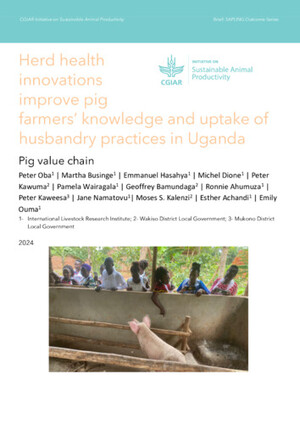
Factors affecting household decision to allocate credit for livestock production: Evidence from Ethiopia
Abstract
Purpose – The purpose of this paper is to explore the factors that affect farmer’s decision to allocate credit for livestock production. The results are expected to contribute to the understanding of what motivates smallholders to allocate credit to agricultural production in general and livestock production in particular. A better understanding of the farmers’ behavior in allocating credit for livestock would provide useful information for project implementers and financial institutions that work with small-scale livestock producers. Design/methodology/approach – A cross-section data set collected in 2014 from 5,000 households and 497 rural communities in the major highland regions of Ethiopia is examined. The authors developed a conceptual framework for credit allocation decision. Percentiles, means, and standard deviation as well as t, χ2 and Fisher’s exact tests for association and Cramer’s V measure for strength of association have been used to describe the status of farmer’s access to credit and analyze credit utilization, while a three-stage probit model with double sample selection is used to identify factors that affect household’s decision to allocate credit for livestock production. Findings – After controlling for potential selection biases, sex and literacy status of household head, land size, wealth and access to livestock centered extension service are found to have a statistically significant effect on farmers’ decision to allocate credit to livestock production. The results showed female-headed households, wealthy farmers, farmers with small plot of land and farmers that have access to livestock centered extension services are more likely to allocate the credit for livestock production. The results suggest that policies aimed at improving access to credit together with access to livestock focused extension service are more effective in increasing livestock production. Research limitations/implications – The study’s findings should be viewed with perspective and caution, as only households with excess demand for credit were the subject of the research. Originality/value – The contribution of this paper is twofold. First, it is one of a very few empirical studies that try to identify factors that affect households credit allocation to livestock in systematic way that removed confounding effects using three-stage probit models. Given the emphasis on financial constraints in livestock development, new empirical insights on household credit allocation are essential to better inform development interventions. Second, the analysis relies on a comprehensive data set that represents the major agricultural system of the country
Citation
Shiferaw, K., Gebremedhin, B. and Zewdie, D.L. 2017. Factors affecting household decision to allocate credit for livestock production: Evidence from Ethiopia. Agricultural Finance Review 77(4): 463-483









